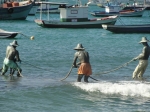Information about Buzios
Armação dos Búzios or just Búzios is a member of the State of Rio de Janeiro, the Brazilian coast 190 kilometers east of Rio de Janeiro Brazilian municipality. This former fishing village is now a tourist destination that attracts tourists each year in search of its beaches and nightlife. Its population is 27 701 inhabitants and its area of 69 km.
It is located on a peninsula 8 km long with 23 beaches. On the one hand it receives equatorial currents and on the other those from the South Pole, making that has beaches with warm water and frost at once. Among the main beaches stand out Geriba, João Fernandes, Ferradura, Ferradurinha, Rasa, Manguinhos, Tartaruga, Brava and Olho de Boi, the latter reserved for the practice of nudism. It is nearly 27 km from Cabo Frio, the nearest city, whose municipality depended administratively until 1995.
In Buzios a relationship with foreigners who come from the time of discovery of Brazil. According to Cunha (1896), in the sixteenth century tupinambas Indians they occupied this area, where they practiced fishing, hunting and growing manioc and corn. They maintained close relations with privateers and French smugglers, who hid in the woods location for smuggling, mainly the pau-brasil (Caesalpinia echinata), and sell slaves. Later, in the seventeenth century, the French were expelled by the Portuguese after bloody disputes which significantly lowered the indigenous population. Later, the area was earmarked for agriculture and cattle raising activities of large estates, where fishing in this stretch of coast prohibited. After the ban, the local economy remained for a long period based on fishing and agriculture on a small scale until mid-twentieth century, when they began to emerge totally different to the traditional activities related to tourism.







